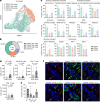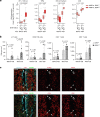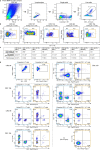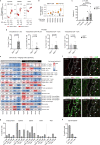γδ T cells are effectors of immunotherapy in cancers with HLA class I defects
- PMID: 36631610
- PMCID: PMC9876799
- DOI: 10.1038/s41586-022-05593-1
γδ T cells are effectors of immunotherapy in cancers with HLA class I defects
Abstract
DNA mismatch repair-deficient (MMR-d) cancers present an abundance of neoantigens that is thought to explain their exceptional responsiveness to immune checkpoint blockade (ICB)1,2. Here, in contrast to other cancer types3-5, we observed that 20 out of 21 (95%) MMR-d cancers with genomic inactivation of β2-microglobulin (encoded by B2M) retained responsiveness to ICB, suggesting the involvement of immune effector cells other than CD8+ T cells in this context. We next identified a strong association between B2M inactivation and increased infiltration by γδ T cells in MMR-d cancers. These γδ T cells mainly comprised the Vδ1 and Vδ3 subsets, and expressed high levels of PD-1, other activation markers, including cytotoxic molecules, and a broad repertoire of killer-cell immunoglobulin-like receptors. In vitro, PD-1+ γδ T cells that were isolated from MMR-d colon cancers exhibited enhanced reactivity to human leukocyte antigen (HLA)-class-I-negative MMR-d colon cancer cell lines and B2M-knockout patient-derived tumour organoids compared with antigen-presentation-proficient cells. By comparing paired tumour samples from patients with MMR-d colon cancer that were obtained before and after dual PD-1 and CTLA-4 blockade, we found that immune checkpoint blockade substantially increased the frequency of γδ T cells in B2M-deficient cancers. Taken together, these data indicate that γδ T cells contribute to the response to immune checkpoint blockade in patients with HLA-class-I-negative MMR-d colon cancers, and underline the potential of γδ T cells in cancer immunotherapy.
© 2023. The Author(s).
Conflict of interest statement
M.C. has performed an advisory role or offered expert testimony for BMS, MSD and NUMAB; has received honoraria from BMS and Roche; and has received financing of scientific research from Roche, BMS and MSD. J.B.H. has received research funding from BMS; and has performed an advisory role for BMS.
Figures














Comment in
-
γδ T cells mediate immunotherapy responses when cancers lack MHC class I.Nat Rev Immunol. 2023 Mar;23(3):137. doi: 10.1038/s41577-023-00842-4. Nat Rev Immunol. 2023. PMID: 36726035 No abstract available.
-
γδ T cells maintain sensitivity to immunotherapy in MHC-I-deficient tumors.Nat Immunol. 2023 Mar;24(3):387-388. doi: 10.1038/s41590-023-01429-w. Nat Immunol. 2023. PMID: 36781987 No abstract available.
-
γδ T cells turn the tables on immune-evasive colon cancer.Med. 2023 Mar 10;4(3):141-142. doi: 10.1016/j.medj.2023.02.007. Med. 2023. PMID: 36905925
References
-
- Ionov Y, Peinado MA, Malkhosyan S, Shibata D, Perucho M. Ubiquitous somatic mutations in simple repeated sequences reveal a new mechanism for colonic carcinogenesis. Nature. 1993;363:558–561. - PubMed
-
- Germano G, et al. Inactivation of DNA repair triggers neoantigen generation and impairs tumour growth. Nature. 2017;552:116–120. - PubMed
Publication types
MeSH terms
Substances
Supplementary concepts
LinkOut - more resources
Full Text Sources
Other Literature Sources
Molecular Biology Databases
Research Materials
Miscellaneous

